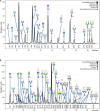Changes in Specific Biomarkers Indicate Cardiac Adaptive and Anti-inflammatory Response of Repeated Recreational SCUBA Diving
- PMID: 35360010
- PMCID: PMC8964121
- DOI: 10.3389/fcvm.2022.855682
Changes in Specific Biomarkers Indicate Cardiac Adaptive and Anti-inflammatory Response of Repeated Recreational SCUBA Diving
Abstract
Objective: Recreational SCUBA (rSCUBA) diving has become a highly popular and widespread sport. Yet, information on molecular events underlying (patho)physiological events that follow exposure to the specific environmental conditions (hyperbaric conditions, coldness, immersion, and elevated breathing pressure), in which rSCUBA diving is performed, remain largely unknown. Our previous study suggested that repeated rSCUBA diving triggers an adaptive response of cardiovascular and immune system. To elucidate further molecular events underlying cardiac and immune system adaptation and to exclude possible adverse effects we measured blood levels of specific cardiac and inflammation markers.
Methods: This longitudinal intervention study included fourteen recreational divers who performed five dives, one per week, on the depth 20-30 m that lasted 30 min, after the non-dive period of 5 months. Blood samples were taken immediately before and after the first, third, and fifth dives. Copeptin, immunoglobulins A, G and M, complement components C3 and C4, and differential blood count parameters, including neutrophil-to-lymphocyte ratio (NLR) were determined using standard laboratory methods. Cell-free DNA was measured by qPCR analysis and N-glycans released from IgG and total plasma proteins (TPP), were analyzed by hydrophilic interaction ultra-performance liquid chromatography.
Results: Copeptin level increased after the first dive but decreased after the third and fifth dive. Increases in immunoglobulins level after every dive and during whole studied period were observed, but no changes in C3, C4, and cfDNA level were detected. NLR increased only after the first dive. IgG and TPP N-glycosylation alterations toward anti-inflammatory status over whole studied period were manifested as an increase in monogalyctosylated and core-fucosylated IgG N-glycans and decrease in agalactosylated TPP N-glycans.
Conclusion: rSCUBA diving practiced on a regular basis promotes anti-inflammatory status thus contributing cardioprotection and conferring multiple health benefits.
Keywords: N-glycosylation; cell-free DNA; complement C3 and C4; copeptin (CPP); immunoglobulin; neutrophil-to-lymphocyte ration (NLR); recreational SCUBA (rSCUBA) diving.
Copyright © 2022 Dumić, Cvetko, Abramović, Šupraha Goreta, Perović, Njire Bratičević, Kifer, Sinčić, Gornik and Žarak.
Conflict of interest statement
The authors declare that the research was conducted in the absence of any commercial or financial relationships that could be construed as a potential conflict of interest.
Figures







Similar articles
-
Effects of recreational SCUBA diving practiced once a week on neurohormonal response and myokines-mediated communication between muscles and the brain.Front Cardiovasc Med. 2023 Mar 29;10:1074061. doi: 10.3389/fcvm.2023.1074061. eCollection 2023. Front Cardiovasc Med. 2023. PMID: 37063956 Free PMC article.
-
Adaptive response triggered by the repeated SCUBA diving is reflected in cardiovascular, muscular, and immune biomarkers.Physiol Rep. 2021 Jan;9(2):e14691. doi: 10.14814/phy2.14691. Physiol Rep. 2021. PMID: 33463896 Free PMC article.
-
[Scuba diving and the heart. Cardiac aspects of sport scuba diving].Herz. 2004 Jun;29(4):406-13. doi: 10.1007/s00059-004-2581-5. Herz. 2004. PMID: 15241540 Review. German.
-
Effects of recreational scuba diving on erythropoiesis-"normobaric oxygen paradox" or "plasma volume regulation" as a trigger for erythropoietin?Eur J Appl Physiol. 2020 Jul;120(7):1689-1697. doi: 10.1007/s00421-020-04395-5. Epub 2020 Jun 1. Eur J Appl Physiol. 2020. PMID: 32488585
-
Effects of diving and oxygen on autonomic nervous system and cerebral blood flow.Diving Hyperb Med. 2013 Sep;43(3):148-56. Diving Hyperb Med. 2013. PMID: 24122190 Review.
Cited by
-
Effects of Environmental Conditions on Athlete's Cardiovascular System.J Clin Med. 2024 Aug 22;13(16):4961. doi: 10.3390/jcm13164961. J Clin Med. 2024. PMID: 39201103 Free PMC article. Review.
-
Laboratory medicine and sports: where are we now?Biochem Med (Zagreb). 2024 Oct 15;34(3):030501. doi: 10.11613/BM.2024.030501. Epub 2024 Aug 5. Biochem Med (Zagreb). 2024. PMID: 39171092 Free PMC article. Review.
-
Oxy-Inflammation in Humans during Underwater Activities.Int J Mol Sci. 2024 Mar 6;25(5):3060. doi: 10.3390/ijms25053060. Int J Mol Sci. 2024. PMID: 38474303 Free PMC article. Review.
-
Effects of recreational SCUBA diving practiced once a week on neurohormonal response and myokines-mediated communication between muscles and the brain.Front Cardiovasc Med. 2023 Mar 29;10:1074061. doi: 10.3389/fcvm.2023.1074061. eCollection 2023. Front Cardiovasc Med. 2023. PMID: 37063956 Free PMC article.
References
-
- Confédération Mondiale des Activités Subaquatiques (CMAS) (World Underwater Federation). International Diver Training Standards and Procedures Manual Chapter 1: Universal Standards and Procedures. (2012). Available online at: https://www.cmas.org/technique/general-documents (accessed January 8, 2022).
LinkOut - more resources
Full Text Sources
Molecular Biology Databases
Miscellaneous

